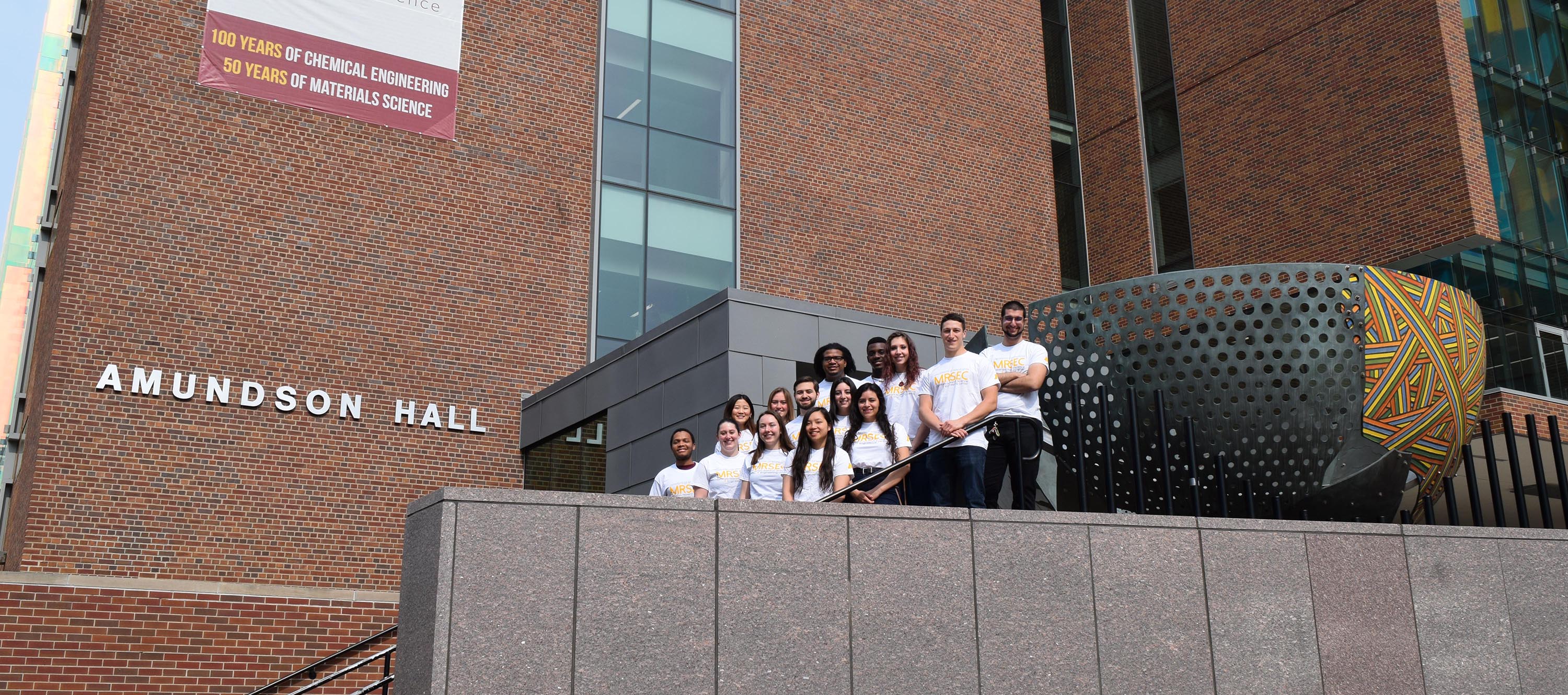

Home Institution: University of Maryland, Baltimore County
REU Mentor: Bharat Jalan and Richard James
Annealing thin films and preparing new MBE systems
Thin film nanomaterials are used to improve the electron mobility of semiconducting
devices. A common manufacturing method for thin films is Molecular Beam Epitaxy (MBE),
which allows the semiconducting material to be grown at a high quality on the surface of a
substrate. Closer inspection with Atomic Force Microscopy (AFM) reveals an uneven surface
that reduces the conductivity of the material. Further observations with X-ray Diffraction (XRD)
reveals rocking curves with poorly defined peaks which indicate low quality crystal structure in
the material. The limited electron mobility of 60cm2V-1s-1
is evidence that the structure of the material is restricting the potential conductivity of the film. This research will focus on
improving the quality of films of doped and undoped strontium stannate (SrSnO3) by annealing
the material over a temperature range of 900 - 1200°C. AFM and XRD scans will be performed
after each 100°C temperature increase to observe how increasing temperature impacts the
surface, and the crystal structure of the material. The conductivity of the film will also be
measured to observe any changes in the electron mobility of the film after each temperature step
in the annealing process. The results of this research may lead to the improvement of the MBE
process and consistently produce higher quality thin films for semiconducting devices.
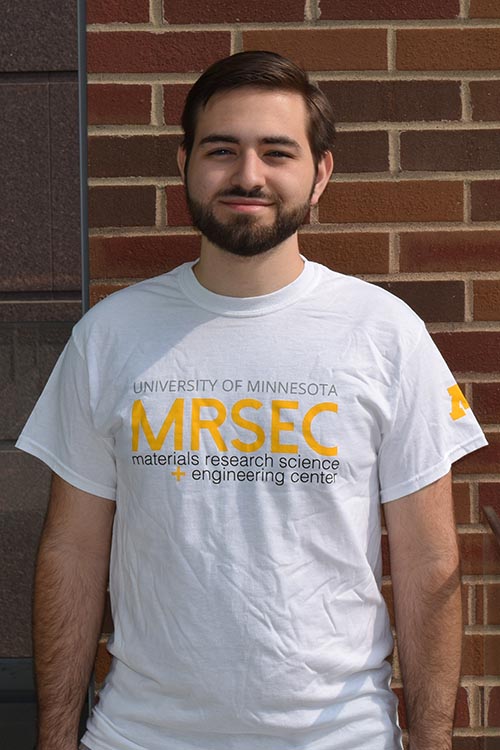
Home Institution: University of Florida
REU Mentor: XiaoJia Wang
Usage of Labview-Based Control System in MOKE Measurement for the Improvement of Data Storage
Data storage is an incredibly important part of modern technology. With increasing volumes of data to be stored, more and more storage space is needed. The amount of data stored in a given area with current technology has increased over time, but an impasse is about to be met. Two-Dimensional Magnetic Recording, what is used today, cannot get much more space-efficient than it currently is due to magnetic interference. A newer technology, Heat Assisted Magnetic Recording, is currently being researched. This technology uses a diode laser to selectively and very quickly heat up individual grains that act as bits. At this elevated temperature, it is easier to write the binary data onto the bit, before the data is locked in by cooling. This allows bit size to become smaller, thereby fitting nearly five times as much storage per unit volume of drive. To advance this technology, ideal materials for the bits must be researched and found. Extensive testing of the thermal and magnetic properties of different materials when exposed to the ultrafast laser pulses of the HAMR is necessary. A model 5403 GMW electromagnet is being used in this laboratory to provide a field simulating that of a data writer, while a Hall Probe is being used to measure the field’s effects on the materials. An efficient digital control system for the electromagnet is needed for accurate experiments, which I will be creating using Labview. This system will manage the output of the power supplies to control the field output.
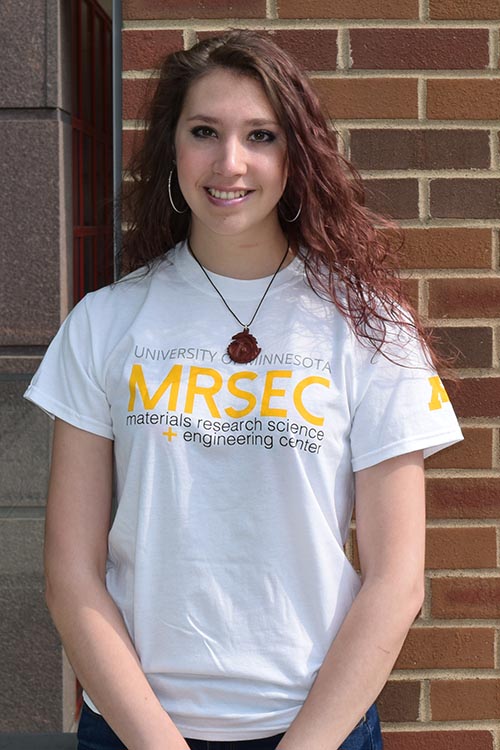
Home Institution: Allegheny College
REU Mentor: Dan Frisbie
Overcoming Parasitic Capacitance in Sensing Floating Gate Electrolyte-Gated Transistors
(FG-EGTs)
Biosensing has come far in recent years with techniques such as optical microscopy and ELISA kits, which are not favorable due to the need of trained personnel and prolonged response
times. Floating gate, electrolyte-gated transistors (FG-EGTs), however, show promise for advancements in the field due to their portability and ease of fabrication. FG-EGT sensors are
devices where the floating gate is functionalized with bioreceptors, acting as the sensing pad, and is capacitively coupled to the EGT. Upon a binding event, the FG-EGT can elicit a response
based on a potentiometric change, such as changes in capacitance and/or charge, at the sensing pad. The transistor’s response is transduced into an electrical signal and then processed to
provide an electronic readout, detailing the binding of the analyte of interest at the sensing pad. This project will focus partly on altering the sensing pad size to see how device response is
affected, and partly to investigate ways to reduce parasitic capacitance between the floating gate and substrate. Parasitic capacitance causes less polarization of the electrolyte due to trapped
charges at the gold/silicon interface, necessitating a larger gate voltage to turn on the device. By changing the substrate to glass, an insulating material, parasitic capacitance can be eliminated.
Using photolithography, the gold electrodes for the FG-EGT will be fabricated on the substrate. Subsequently, the semiconductor and electrolyte will be printed using an aerosol jet printer.
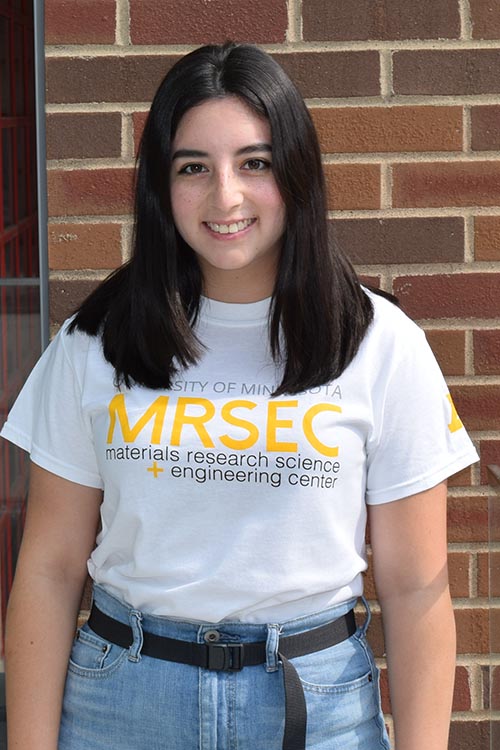
Home Institution: University of Texas Rio Grande Valley
REU Mentor: Theresa Reineke
Synthesis of Cationic Triblock Terpolymer for Complexation of Nucleic Acids
Polyelectrolyte complexes are formed spontaneously when oppositely charge polyions are mixed. The study of these materials is a thriving research field due to unsolved fundamental
questions about their formation process and their structures. These complexes find applications in water treatment, as adhesive materials, and in the pharmaceutical industry as excipients in
drug formulations and as carriers for protein-based or genetic therapies. In specific for genetic therapies, complexation and protection of the nucleic acid cargo (e.g., DNA or RNA) is
necessary for achieving efficient therapies. ABC triblock terpolymers mPEG-b-poly(DMAEMA)-b-poly(nBA) can self-assemble into nanoscopic cationic particles called
“micelles” that have shown promising results in the complexation of plasmid DNA into colloidally stable complexes with controlled structures called “micelleplexes”. In our project we
are synthesizing a library of cationic triblock terpolymers, where we systematically change the cationic middle block. The library will be synthesized via reversible addition-fragmentation
chain transfer polymerization followed by post-polymerization modification techniques, which will allow us to synthesize polymers with analogous degrees of polymerization. After
synthesizing the library, cationic micelles will be prepared using a solvent exchange method, and their complexation with different nucleic acids will be explored, to understand the effects of the
cationic middle block in the stability and structure of the complexes formed.
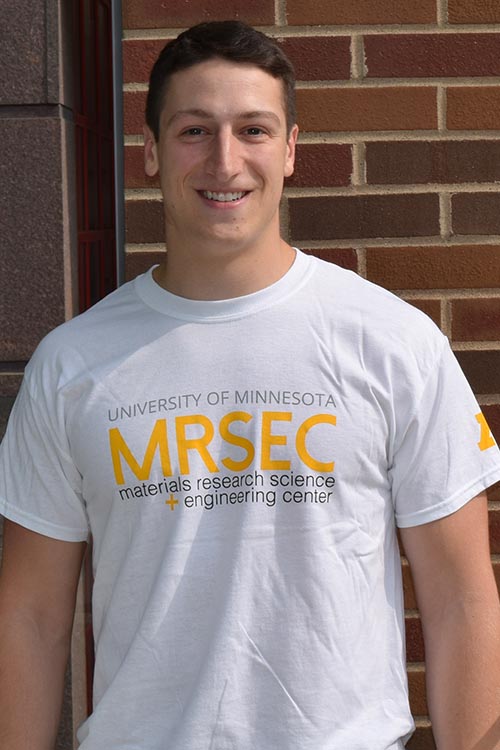
Home Institution: University of Connecticut
REU Mentor: Jeong-Hyun Cho
Doping Effects on Graphene Plasmon
The purpose of this project is to determine if graphene can be doped through a boundary layer of aluminum oxide (Al2O3). The ability to dope graphene through a boundary layer is appealing as it would allow for graphene
to be protected from radiation, surface damage, and so on, while still being able to optimize its electronic and optical properties by accepting a dopant. Plasmon is the discrete quantity of energy of the collective
oscillation of electrons. The analysis of graphene plasmon, through Fourier Transform Infrared Spectroscopy (FTIR), will determine if the graphene has been effectively doped. To explore this, graphene samples will be patterned into
nano-ribbons to facilitate plasmon analysis. Varying thicknesses of layers of Al2O3 will be applied to the samples by an electron beam evaporator through physical vapor deposition. The samples will then be doped
with nitric acid vapor for a set amount of time. The doped graphene nano-ribbons will then undergo FTIR to evaluate the behavior of plasmon resonance in the sample. The results of FTIR will lead to a conclusion as to whether or not
doping through a boundary layer of aluminum oxide is possible.

Home Institution: New York University
REU Mentor: Andre Mkhoyan
[no title]
Metal Organic Frameworks (MOFs) are crystalline substances that consists of metallic atoms bonded together by organic linkers. These organic linkers can be of any type i.e. Benzene,
pentane, cyclohexane, etc. MOFs are electron beam sensitive material and are easily damaged by the method of analysis (Transmission electron Microscopy or TEM). However, because of these
organic linkers, when exposed to an electron beam at energies of 100 keV or (1.602 -14 J), the bonds begin to break and the results that are obtained are not representative of the parent
structure. This is known as radiolysis. Although the energy is relatively small, so is the sample. In addition, the breaking of bonds in MOFs can result in undesired side products and
consequently; the damaged parent substance as a whole has a different diffraction pattern than the pre damaged parent substance. Metal Organic Frameworks are also susceptible to a different
type of electron beam damage. When the energy of a Transmission Electron Microscope/Microscopy is reduced, so is the chance of radiolysis damaging your sample.
However, there are times when an atom is pushed out of position by the onslaught of electrons by the beam; which is called knock on damage. This displacement of the atom reduces the
atomic structural integrity of the substance. We plan to use time-resolved electron diffraction (ED) to quantify the rate of damage and understand the mechanisms for the damage.
In addition, we will conduct an analysis of these ED patterns for MOFs at different operating conditions in the TEM.
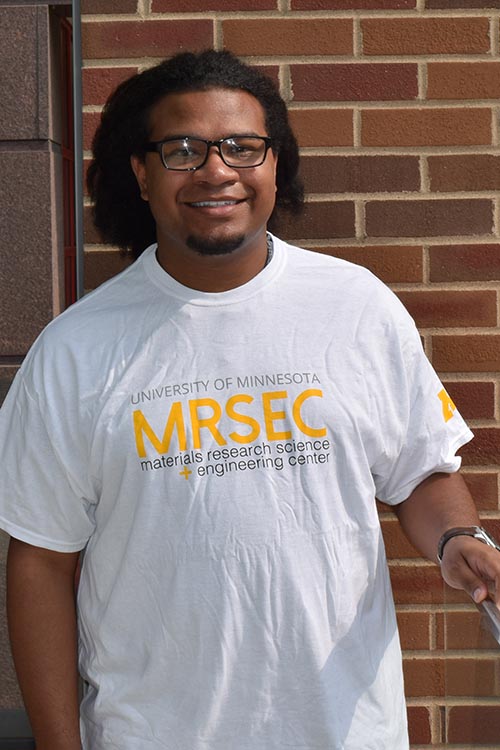
Home Institution: Montana Technological University
REU Mentor: Chris Hogan
Calcium Copper Titanite Nanoparticles produced via Flame Spray Pyrolysis
Calcium Copper Titanite (CCTO) is an electro-ceramic material valued for its incredible dielectric
properties. CCTO has a cubic perovskite-type structure with the chemical formula CaCu3Ti4O12. This
material exhibits a low dielectric loss, high thermal stability, and a high dielectric constant. The dielectric
permittivity of CCTO is greater than 10,000 at room temperatures and over wide ranges of frequency.
This makes CCTO an excellent dielectric material for applications in capacitive sensors and actuators.
The focus of this research will be on the synthesis and characterization of CCTO produced via flame
spray pyrolysis (FSP). The FSP system has two inlet flows; a methane gas fuel source used to sustain the
flame and an atomized precursor solution. The output of the system is an aerosol that contains CCTO
nanoparticles which are then collected by a filter. Characterization of the CCTO will be conducted to
verify its morphology, composition, and crystal structure. The morphology of CCTO will be investigated
using a scanning electron microscope (SEM). The crystal structure and composition of CCTO will be
determined through x-ray diffraction (XRD). It’s anticipated that the method of flame spray pyrolysis will
sufficiently yield CTTO nanoparticles.
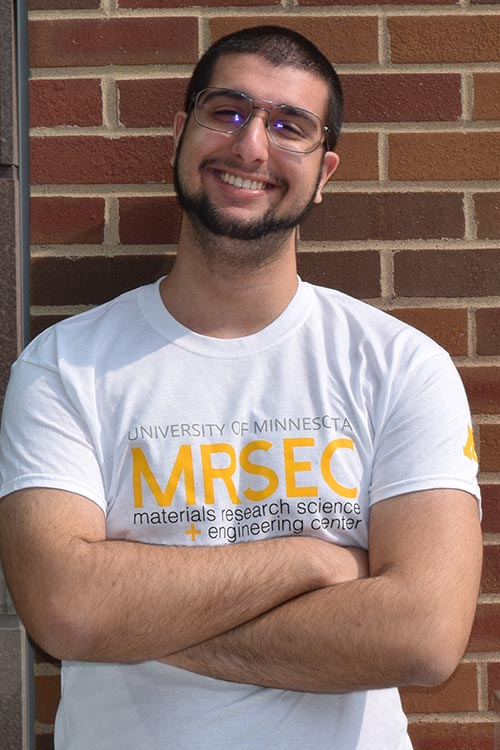
Home Institution: University of Texas Rio Grande Valley
REU Mentor: Uwe Kortshagen
[no title]
Thermoelectric generators are a major player for waste heat recovery that convert heat flows directly into useable electrical energy. Silicon-germanium (SiGe) thin films are low cost and low toxicity candidates for
high temperature thermoelectric applications. Thin films of p-type boron doped amorphous SiGe are deposited on quartz substrates via Plasma Enhanced Chemical Vapor Deposition (PECVD). Post deposition, polycrystalline
structure is obtained by thermal annealing of the samples at high temperatures. Good thermoelectric converter materials have a high Seebeck coefficient, high electrical conductivity and low thermal conductivity.
Unfortunately, this combination of properties is rare.
The main goal of this summer project is to study the annealing process of boron doped amorphous SiGe thin films. Samples will be annealed in a furnace with nitrogen environment and varying temperatures, between 600°C to 1100°C.
After this post deposition step, the thickness of the samples will be measured by a profilometer. In order to find the thermoelectric properties, the dark conductivity and Seebeck coefficient will be measured in a vacuum chamber.
The naturally formed grain boundaries are found to play a crucial role in determining both the charge and thermal transport properties of the films. Therefore, X-ray diffraction (XRD) will be conducted to find the variation of the
grain size by annealing process as well as its relevance to the changes of thermoelectric properties.
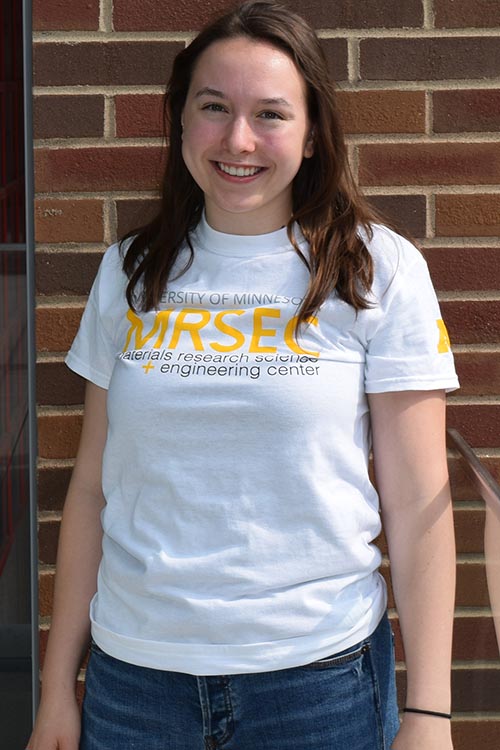
Home Institution: University of Wisconsin-Madison
REU Mentor: Bharat Jalan
Electrostatic Control of Electronic Transport Properties of β- Ga2O3
β-gallium oxide is the most stable form of gallium oxide and has a large
bandgap of 4.8 eV, electron mobility of 300 cm2/Vs, breakdown field of 8 MV⁄cm, and a dielectric constant of 10 in the bulk. These high values are what
makes gallium oxide of interest to study as a possible replacement for conventionally used silicon. Thin films of gallium oxide were synthesized using metal organic chemical vapor deposition (MOCVD). Its
structure-property relationship will be probed by electrostatic gating techniques by transforming the material into a hall-bars device using ion gel
in order to understand the mobility limiting mechanisms and intrinsic transport properties with the physical property measurement system
(PPMS) at different carrier concentrations. Another goal is to decipher
whether the ion gel has purely an electrostatic effect on the substance or if
it also has an electrochemical effect by permanently changing the
electronic properties of Ga2O3. After identifying the intrinsic properties of
gallium oxide, the goal is to find the applicability of ion gel gating on the
material for use as a transistor in electronics.
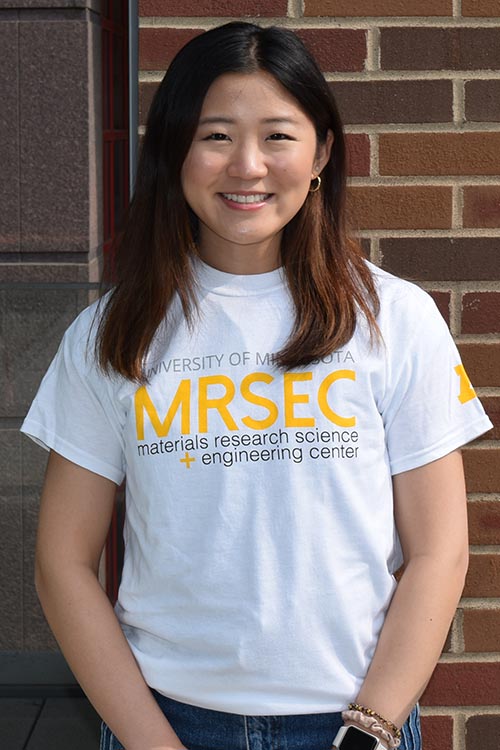
Home Institution: University of Michigan
REU Mentor: Samira Azarin
Iron-oxide-loaded polymeric scaffolds for non-invasive localized heating of
metastatic ovarian cancer cells
Metastatic cancer is the spread of tumor cells from the primary site of origin in other
areas of the body. Since metastasis often remains undetected until the burden of
disease is too high, there are few therapeutic options for its treatment. Microporous
polymer scaffolds composed of poly(ε- caprolactone) (PCL) have been shown to have
the ability to capture metastasizing cancer cells when implanted in the subcutaneous
space, leading to improved survival and a reduction of tumor cells spreading to
metastatic sites. In order to improve the therapeutic potential of the polymeric scaffold,
the Azarin Lab aims to use thermal therapy to destroy the tumor cells that accumulate
within the scaffold. Localized heating to over 50°C for a short time period (seconds to
minutes) has been shown to effectively reduce cell survival. Iron oxide (Fe3O4) will be
incorporated into the PCL scaffolds to give the scaffolds the ability to generate heat
through electromagnetic induction by a magnetic field. The Fe3O4 particle size, Fe3O4
loading amount, and magnetic field strength parameters will be optimized to obtain
ideal heating of the scaffold. Ovarian cancer cells will then be seeded within the
scaffolds and tested in the magnetic field to determine if the generated heat can effectively destroy tumor cells within the scaffold in vitro. We hypothesize that the PCL-
iron oxide scaffolds will be able to generate localized heat over 50°C and successfully destroy infiltrated cancer cells. Further studies will investigate the therapeutic
capabilities of the PCL-iron oxide scaffolds in vivo.
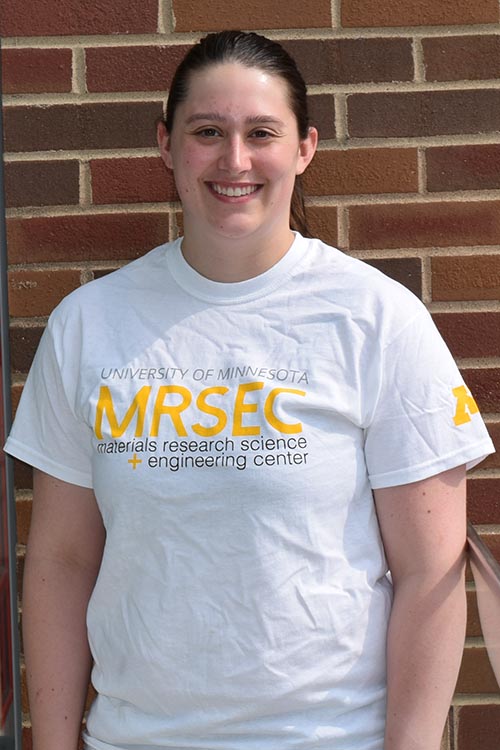
Home Institution: Pacific Lutheran University
REU Mentor: Mahesh Mahanthappa
Investigating the order-to-disorder transition temperature for asymmetric core-
shell bottlebrush copolymers
Polymers are a growing field of interest in material science and engineering for their ability to
self-assemble into varied microstructures with tunable domain sizes. Diblock and triblock
copolymers are of particular interest in nanolithography and microchips due to their potential to
reach sub-14-nm. This project seeks to investigate how molecular architectures effects order-to-
disorder transition temperatures (TODT) and χN values by covalently pre-ordering triblock
copolymers into core-shell bottle brushes (csBB). We are targeting hexagonally closed packed
cylinders and then analyzing the transition to the disordered phase using temperature dependent
SAXS studies. This csBB polymer structure is synthesized using a difunctional norbornene to
initiate a sequential ring-opening transesterification polymerization (ROTEP) of ε-decalactone
and lactide, followed by a ring-opening metathesis polymerization (ROMP) of the
macromonomer to afford a poly(norbornene) backbone densely grafted with poly(ε-decalactone-b-lactide) arms.
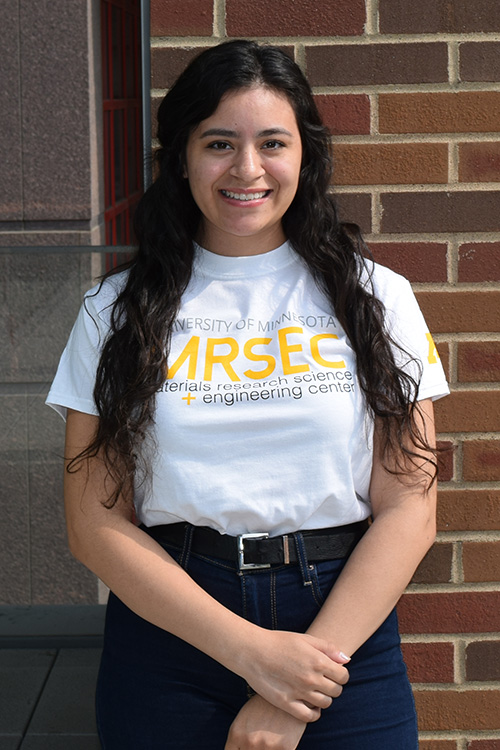
Home Institution: University of Texas Rio Grande Valley
REU Mentor: Stephen Campbell
Black Arsenic Phosphorus
Black phosphorus, a 2-D semiconductor, has been heavily studied for its high mobility and outstanding electrical properties with a band gap of 0.3 eV. A new frontier in black
phosphorus crystal synthesis research is to alloy black phosphorus with varying arsenic compositions. The increase of Arsenic in b-AsxP1-x materials shows a band gap decrease from
0.3 eV to 0.15 eV which allows this material to be used for mid-infrared photodetector devices. One advantage of black arsenic phosphorus is that it has an increased resistance to surface
oxidation degradation which is a serious limitation of black phosphorus devices. Currently, black arsenic devices are fabricated by mechanical exfoliation processes which is not scalable to an
industrial level. The aim is to synthesize the black arsenic phosphorus directly onto a silicon wafer in a highly crystalline, uniform, and large area vapor deposition process. A mixture of red
phosphorus, grey arsenic, tin, and tin tetraiodide will be placed in a glass tube, evacuated and sealed. The ampule will be placed in a furnace and will go through a 24-hour heating program
resulting in phase formation and crystal growth. Using Raman Spectroscopy instrument, it can be shown the peak-peak distance, peak frequency, and peaks are similar for the exfoliated thin bAsP flakes, there aren’t any noticeable
shifts, and the anisotropic properties were confirmed with the infrared absorption studies. X-Ray Diffraction will allow us to determine the crystal structure of the synthesized black arsenic
phosphorus. The thin flakes found on the wafer had a decrease of oxidation degradation compared to the previous samples made and had 35 to 40 percent arsenic in the crystal shown in
the Auger Electron Spectroscopy results. There was less tin found on the surface of the sample compared to the amount on pure black phosphorus using the starting reactant ratio that is
optimized for thin film black phosphorus.
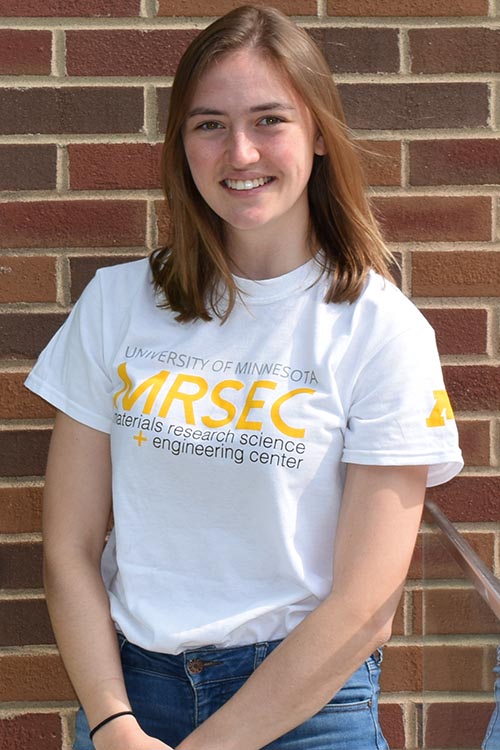
Home Institution: University of Wisconsin - Madison
REU Mentor: David Flannigan
Modeling the Behavior of Soft Material to Mitigate Radiolysis Damage Induced by a
Transmission Electron Microscope
The transmission electron microscope (TEM) has proven to be a powerful tool in quantifying material behavior. Fundamentally, this microscope uses electron scattering to produce contrast
images of the sample. This contrast allows for three-dimensional information to be depicted on a two-dimensional image with incredibly high resolution. Despite this, resolution is limited by the
damage induced to the sample due to TEM electron interactions with the specimen. Among other mechanisms, radiolysis damage, or the atomic ionization damage caused by inelastic collisions,
has proven to be problematic when studying the behavior of soft materials. These collisions alter material behavior– fundamentally preventing a single, isolated variable to be studied. A deeper
understanding of these interactions will ultimately aid in mitigating the effects of induced specimen damage. To accomplish this, data has been collected quantifying the interactions
between hexatriacontane, a soft material, and the TEM electron beam. After studying these interactions, hexatriacontane has been observed to exhibit strain relaxations and lose crystallinity, eventually becoming an amorphous material.
Modeling this behavior allows for the analysis of material behavior changes when exposed to a given electron dosage. Determining a relationship between electron dosage and soft material behavior aids in the development of a
TEM methodologies, and thus widens applications of TEM technology.

Home Institution: Tufts University
REU Mentor: Ben Hackel
Selective Inhibition of Carbonic Anhydrase Through Fibronectin-Acetazolamide Fusion
Antibodies have been commonly used for many clinical and scientific applications including imaging, therapeutics, diagnostics, detection, purification, etc. However, off-target effects due
to their inability to be highly specific can be harmful and thus, prompted development of a protein-small molecule fusion to combine the specificity of a protein scaffold with the inhibitor
properties of the small molecule. Through this conjugation, this project aims to selectively inhibit specific carbonic anhydrase(CA) enzyme active sites: CA2 and CA9. The 10th type III
domain of human fibronectin (Fn3) has been reported to be an effective scaffold for molecular recognition. Furthermore, Fn3 contains three solvent-exposed loops, which allow improvement
of binding properties through diversification. Affinity maturation of the current Fn3 library will be conducted via triple saturation mutagenesis, in which variants will be transformed into yeast
by electroporation. Upon conjugation with inhibitor acetazolamide through click chemistry, fluorescent activated cell sorting (FACS) will be used to select lead clones. Finally, carbonic
anhydrase esterase assay will be performed with the bacteria grown lead clones for determination of inhibition(KI) and specificity. The result anticipates a high nanomolar and low
micromolar inhibition with varying degrees of specificity.
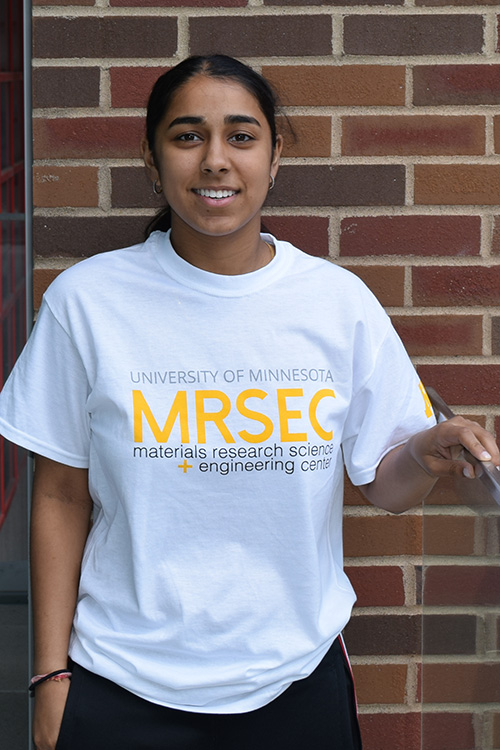
Home Institution: Oregon State University
REU Mentor: Vivian Ferry
Deposition of Germanium Telluride Nanoparticle films
GeTe has a high refractive index, making it very useful for photonic applications. Additionally, GeTe is a phase change material that can switch between the amorphous and crystalline phase, with a corresponding change in refractive index. Thus, the capability to switch between phases would be advantageous as it could enable switchable photonic structures. In this work, GeTe will be synthesized colloidally through the hot injection method. The hot injection method allows for a precursor to be injected into a solution to initialize the growth of nanocrystals. Transmission electron microscopy will be performed to measure the size and shape of the particles. Succeeding the synthesis, we will explore ways to make smooth nanoparticle films. A smooth film formation of the GeTe nanoparticles will prevent unwanted scattering and inhomogeneities within the film. A smooth film of the GeTe solution will form through the modifications of the following aspects of the method: concentration, particle size, the evaporation rate of the solvent, and the speed of the spin coater. These films will additionally be characterized using dark field imaging measurements using an optical microscope.
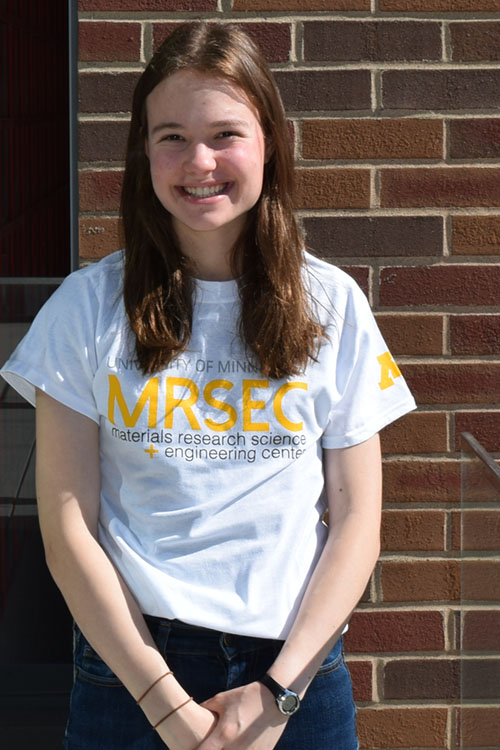
Home Institution: Carleton College
REU Mentor: Tim Lodge
Effect of Polymer Molecular Weight on Block Copolymer Micelle Fragmentation Kinetics
Diblock copolymers are able to self-assemble into spherical micelles in the presence of selective solvents. A greater understanding of the dynamics of these micelles in solution is important for improving usage in applications
including drug delivery, nanoreactors, nanolithography, and viscosity modification. As such, the kinetics of non-equilibrium fragmentation with respect to varying molecular weights will be studied in one ionic liquid. This will be
achieved by the direct dissolution of five molecular weights of poly(1,2-butadiene)-block-poly(ethylene oxide) (PB-PEO) in the ionic liquid 1-ethyl-3-methylimidazolium bis-(trifluoromethyl sulfonyl)imide ([EMIM][TFSI]). The kinetics
of fragmentation will be monitored via temperature-jump dynamic light scattering (T-jump DLS) and liquid-phase transmission electron microscopy (LP-TEM). It is predicted that copolymers with lower molecular weights will lead to micelles
closer to the equilibrium size, reducing the overall time needed for the system to equilibrate.
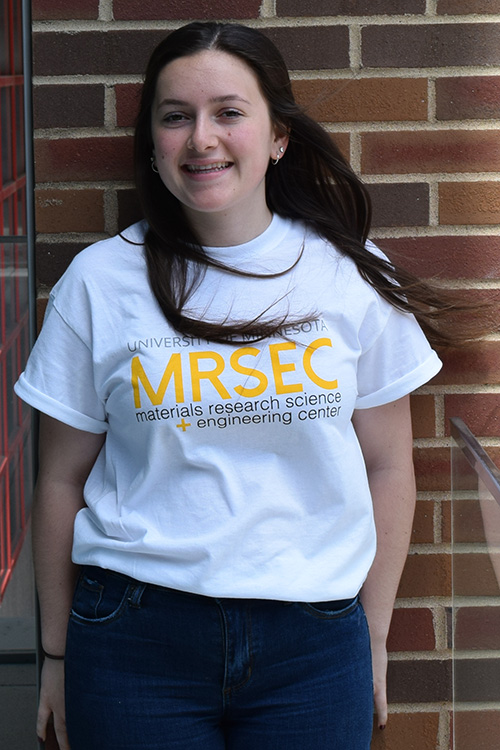
Home Institution: Northwestern University
REU Mentor: Cari Dutcher
Ionic strength and polymer charge effects on flocculation performance in Taylor-Couette flow
The removal of flocs, which are aggregates consisting of solid particulate such as clay, from source water is an essential part of the drinking water treatment process. Optimizing flocculation performance lowers the cost of treatment by lessening the load on the filters further downstream in the process. To improve flocculation performance, salt can be added to increase the solution ionic strength. This creates a charge screening effect and decreases the Debye length, which allows for aggregation of solid particulate. However, increasing the salt concentration would increase the load on reverse osmosis filters down the line, which is cost prohibitive. The addition of long-chained, charged polymer flocculants makes the flocculation possible without adding excess salt to the suspension. Flocculation in a treatment tank is subject to a wide variety of hydrodynamic flow states, and isolating how they affect flocculation is difficult. A Taylor-Couette (TC) cell, which consists of two concentric cylinders where the gap between the cylinders can be filled with particle-laden fluid, can generate precisely defined flow states at specific rotational speeds. The Dutcher group has built a TC cell with radial injection capabilities from the inner cylinder, therefore flocculation of bentonite clay can be captured via image analysis from the start of the process. This TC cell will be used to study how different concentrations of NaCl and percentages of cationic charge on the polymer backbone impact flow dynamics and floc size, growth rate, and configuration.
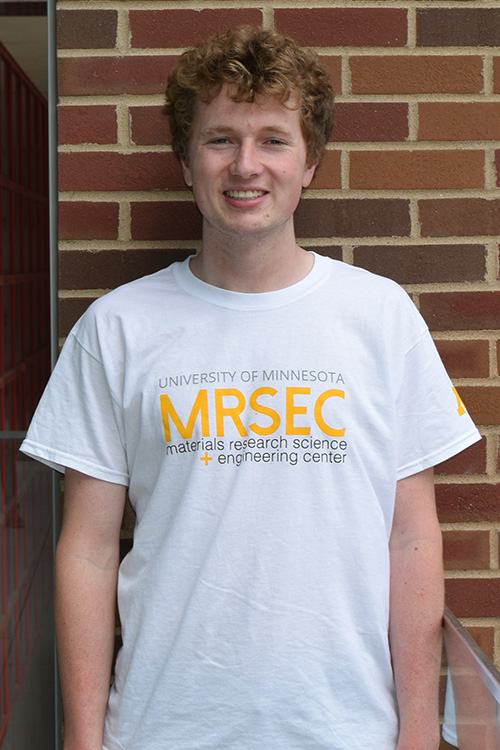
Home Institution: Carleton College
REU Mentor: Chris Leighton
Systematic resistivity measurements of crystalline NiS2 as a function of thickness
We will present resistivity measurements of varying width Nickel disulfide (NiS2) single crystals. From those measurements we hope better understand the properties of crystalline NiS2. We will collect data from the
same crystal over the course of the study. We will leave the surface with contacts attached to it untouched and measure its resistance as a function of temperature. After each set of data collected, we will thin the
crystal by polishing down the back side, before repeating our resistance measurements. By repeating this process until we are unable to thin the crystal any further, we hope to gain an understanding of the interactions
between bulk and surface conduction within NiS2 crystals. We expect to find that the surface resistivity of NiS2 crystals is much higher than their bulk resistivity. No matter the result, this study is necessary to properly
inform any future research on NiS2 crystals.

Home Institution: Carleton College
REU Mentor: Dan Frisbie
Title
Text here.

Home Institution: Carleton College
REU Mentor: Beth Stadler
Electrochemical Synthesis and Characterization of Tellurium Nanowires
Synthesizing tellurium nanowires is of particular interest because of their potential applications to quantum computing. Nanowires will be produced inside porous anodic
aluminum oxide templates with a backing of gold to serve as an electric contact. We will use electrochemical deposition with a pulsed cyclic voltage to fabricate nanowires from a solution
of tellurium dioxide dissolved in sulfuric acid. Using X-ray diffraction and scanning electron microscopy, we will then characterize the uniformity and crystalline structure of these tellurium
nanowires. Our aim is to fabricate tellurium nanowires which could be used in quantum computing applications.
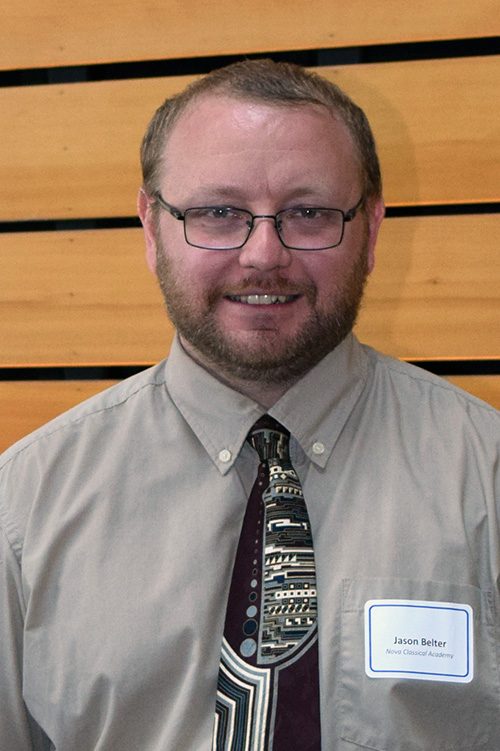
School: Nova Classical Academy
Mentor: Jane Wissinger
Title: Green Chemistry in PLAin Sight
Polylactic Acid (PLA) is a compostable, inexpensive, and readily available renewable polymer. In collaboration with Boston College a lab activity/experiment was developed to highlight one possible use for this polymer: cleaning up oil spills. The experiment involves making thin films of PLA with different characteristics, immersing them in a simulated oil spill and measuring their ability to adsorb dodecane (petroleum stand in). This work investigated the potential of using readily available PLA sources such as 3D printer filament or compostable cups as an alternative to commerical PLA pellets to increasethe feasibilty of classroom implementation. Potential extensions of the original protocols were also explored to aid teachers in customizing the experiment to meet their curricular needs. Long term shelf stability of the PLA/solvent mixture was evaluated.The experiment highlights a number of principles of Green Chemistry and sustainability while also giving students hands on experience with polymer chemistry. Natural extensions of the lab would feature discussions of topics such as plastics in our society, their effect on human health and the environment, and engineering design allowing students to engage in real-world problems to be solved.

School: Spring Lake Park High School
Mentor: Kyle Bantz
Title: Mystery Solved: The Case of the Counterfeit Money
Laboratory experiments provide an opportunity for students to interact with scientific content at a higher level of thinking. Sometimes these laboratory experiments can be isolated from students’ daily lives and will only focus on one major unit from the class, which does not reflect real world laboratory situations. Students are more engaged with laboratory experiments that not only ask them to use cross-unit knowledge but also ask them to solve a tangible problem. Herein, we present a counterfeit ink experiment, which allows students to apply their knowledge of spectroscopy, separations, and acid-base chemistry to solve a counterfeit money crime. The structure of this lab is flexible and allows it to be implemented in a number of chemistry courses; Analytical Chemistry, AP Chemistry and High School General Chemistry and will be modified based on student and teacher feedback. Incorporation of a mystery based critical thinking lab will increase student engagement and understanding of the topics covered in the lab.

School: Shakopee High School
Mentor: Luis Corcoran
Title: An Investigation of Oil Dispersants & Surfactant Chemistry
Oil spills are some of the most high profile of all environmental disasters-and with good reason. They release millions of gallons of toxic crude oil into the environment, causing long-lasting damage to both the environment and economy. Part of the reason is that once released, the clean-up process is exceedingly difficult-but WHY? This lens can be used to introduce high school chemistry students to a range of topics including molecular structure, solubility and mixture separation. The laboratory investigation presented here prompts students to apply the central chemistry concepts described above to a real-world issue: the use of surfactants (dispersants) on oil spills. Students design their own oil dispersant by analyzing marine toxicity and the effectiveness of several potential surfactants. Oil-eating bacteria are then introduced to the dispersed mixtures to determine whether or not dispersion of oil leads to improved bioremediation. Analysis is done without the need for specialized equipment-only a digital camera, making this investigation notonly relevant but also practical and inexpensive.
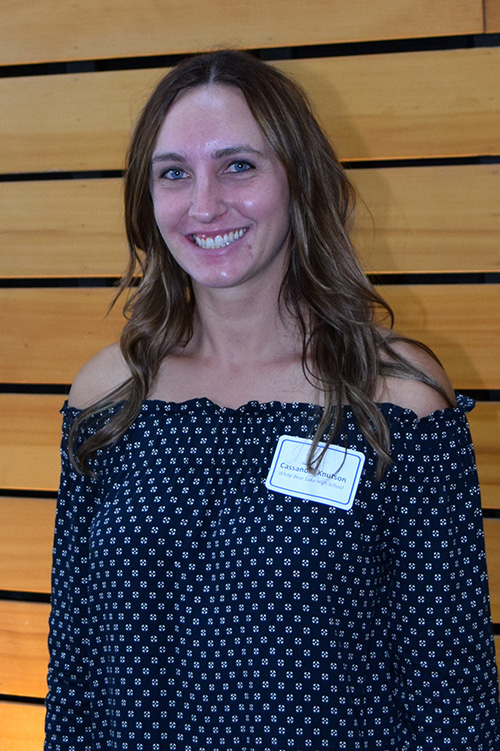
School: White Bear Lake High School
Mentor: Jane Wissinger
Title: Dyeing to Degrade: A Bioplastics Experiment for the College and High School Classroom
Although students are familiar with the problem of plastics accumulating in our environment, their understanding of solutions rarely extends beyond the need for recycling. Consequently, few students can conceptualize current strategies to address the lifecycle and sustainability issues of today’s plastics. This includes innovations to derive plastics from renewable resources rather than fossil fuels and providing alternatives to recycling in the form of biodegradation. Additionally, high school/college curriculum usually lacks in instruction on the structure and properties of polymers. In contrast, when asked, “where are plastics in your daily life?,” students acknowledge the importance of plastics and recognize the accumulation as a problem to be addressed.We developed an experiment which capitalizes on the societal connection of plastics to engage students in learning basic polymer chemistry, laboratory skills, and green chemistry principles. Three biobased polymers are synthesized from combinations of citric acid, glycerol, and tapioca starch. Yellow dye #5 is added to each sample. Each sample is placed in sodium hydroxide and degradation is followed by release of dye. Students time how long each sample takes to degrade or ultraviolet-visiblespectroscopy/smartphone colorimetry is used to follow the release of dye at timed intervals.

School: Central High School, St. Paul Public Schools
Mentor: Turan Birol
Title: Dye Sensitive Solar Cells
Using the engineering design process (new MN Science Standard 3.2.2) students build and try to improve the voltage of dye sensitive solar cells. Students use their prior knowledge of electric circuits to demonstrate and explain thephysical and chemical variables influencing the photoelectric effect.

School: Mankato West High School
Mentor: R. Lee Penn
Title: Dye Sensitive Solar Cells
Iron oxide. Rust. What’s there to know?
There are two kinds, iron (II) oxide and iron (III) oxide. Electrochemistry. Thermochemistry. It’s used in thermite. Familiar. However...There are sixteen iron oxides and iron oxyhydroxides. They are produced under various conditions throughout the world and several are used as catalysts and pigments.Hematite (Fe2O3) is the most abundant iron oxide and is noted for its red color in soil and is used to make steel. Magnetite (Fe3O4) is also used to make steel and is magnetic. However, iron oxides can be made by varying the temperature they are made, the pH of solution they’re made in, and the time needed for crystallization.Student learning outcomes will include material synthesis and determining methods for analysis. Students will be instructed of the basic procedures needed to make iron oxides and the iron oxyhydroxide goethite and allowed to formulate their own procedure. Student analysis will include colorimetry using a mobile phone and determination of the percent composition of their iron oxide samples based upon comparisons to standard samples created by students from the University of Minnesota. Further analysis with the University of Minnesota can include XRD (X-ray diffraction) and TEM (transmission electron microscopy).
UMN MRSEC
435 Amundson Hall, 421 Washington Ave. SE, Minneapolis, MN, 55455
P: 612-626-0713 | F: 612-626-7805